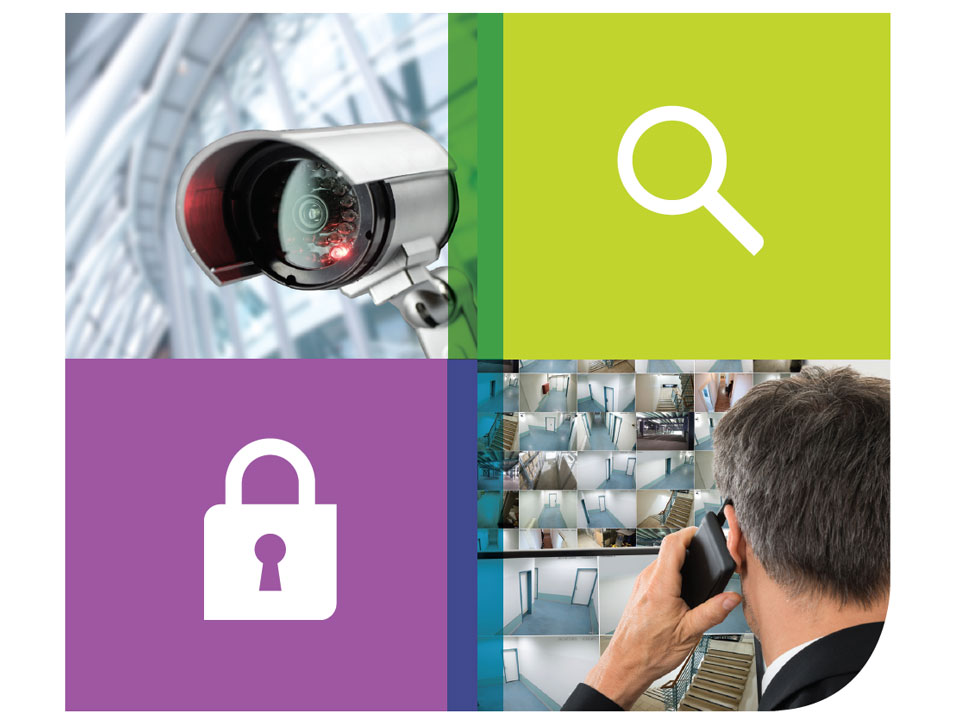
Physical security is that often-hidden, somewhat forgotten, yet crucial part of the business infrastructure. Like many of today’s solutions, the assessment and planning processes that occur beforehand are as important as the technology decisions they make. The top priority is to address each customer’s specific organisation needs. When that’s done properly, solution providers should experience exponential growth in their physical security practice revenue and profitability.
The opportunity is considerable. Like many of today’s technology solutions, physical security has become an essential component of many businesses, with considerable value regardless of organisational size or vertical market. They are commonly found — hidden, in many cases — in banks, retail stores, colleges, and libraries, as well as the corridors of virtually every office building and parking facility today. They have become such a commonplace fixture in the workplace that few people even seem to notice them anymore.
Look around: That’s opportunity.
As market demand for video surveillance continues to grow at a rapid pace, traditional physical security methods are undergoing a transformation. Legacy analogue devices are being replaced or incorporated into the latest IP-based digital technologies. Many companies are taking it slow, employing a hybrid platform strategy to make the transition more cost-effective. It also allows businesses to leverage the best features of both systems while building out their solutions.
That evolution is in full swing, creating new opportunities for providers who are willing to make the commitment — and the right investments. With other physical security-related technologies making similar analogue-to-digital conversions (including access control, intrusion detection, fire detection, and alarms), many channel organisations should find themselves well-positioned to profit from this IT evolution.
That is, of course, if the organisation has the skills and knowledge that business customers want — and need. What does it take to build a profitable and customer-valued offering? This CompTIA Quick Start Guide, Six Steps for Building a Robust Physical Security Practice, details a number of industry best practices to help solution providers evaluate the opportunities and put the right pieces in place.
In fact, the global market for these technologies projected to reach more than $100 billion U.S. dollars by 2020 with very strong annual growth (9.98 per cent compound annual growth rate) according to a recent report from research firm MarketsandMarkets. Who better to connect the latest physical security technologies into a business infrastructure than a skilled professional who already supports the network? Consider the key elements that make up these solutions:
In general, solution providers are network specialists. That can be a significant advantage with the growth of digital security and surveillance (DSS), but analogue still controls a significant amount of the physical security space. Many businesses have made significant investments in their legacy infrastructure and, in some cases, continue to do so.
While the interoperability of IP-based technologies gives providers and end users a wide array of options when building security solutions, for many customers a ‘rip and replace’ strategy may not be the best approach. Previous investments, budget constraints, and organisational objectives all come into play. Hybrid physical security systems, combining digital solutions with existing analogue infrastructure, are proving to be ideal compromises or, in some cases, preferred options. Those who are most successful understand how to assess the unique needs of each business. They incorporate existing infrastructure into their solutions and develop transition plans that strategically replace previous technological investments.
Solution providers looking to build physical security practices need to understand that technological expertise is only part of the equation. The rest will be covered later.
Traditional surveillance used proprietary analogue solutions based on legacy closed circuit television (CCTV) technology. These legacy systems are typically sold in fixed-size ranges that are tied to the number of cameras being Transformation and market demand: Those are two key reasons physical security has become a more lucrative option for solution providers. Whether driven by new regulatory compliance measures or an interest in greater employee protection, businesses are more interested in surveillance and access controls than ever before. The Digital Revolution Creates a Channel Play for Physical Security deployed. Analogue cameras require their own separate cables for video, control, and power, adding cost and complexity to the instals. These legacy surveillance systems — also referred to as CCTV (closed-circuit television) systems — include analogue cameras wired into a digital video recorder (DVR) using coaxial cables. A video monitor connects to the DVR so observers can watch the protected area. The recordings have transitioned from video tape to hard disk file storage over the last several years, but the units have not changed substantially.
DSS systems are much more flexible and readily scaled to meet the changing needs of business customers. A virtually unlimited number of cameras can be deployed through numerous buildings by leveraging existing computer networks. System limitations fall into two categories: bandwidth and physical security management application restrictions.
Advances in DSS camera technology continue to increase its advantages over legacy analogue systems. The latest offerings are higher definition and offer improved coverage, digital zoom, remote monitoring, and on-camera image processing. Many of these features and advances are not available on analogue cameras — a major driver in the digital transformation.

The structure of a digital surveillance system differs in several ways from their analogue counterparts. With smaller systems, the topology of each is quite similar. IP-enabled cameras communicate with an network video recorder (NVR) using a local area network (LAN) connexion. Video management software (VMS) on the NVR controls where captured footage is stored/saved internally and/or offloaded onto a network attached storage (NAS) device. The NVR provides end users with camera monitoring capabilities and allows them to control various aspects of the system.
The primary difference is that everything is connected to the IP standard network with digital platforms, while a separate coaxial cable is required to manage analogue systems. Many digital cameras are power over Ethernet (PoE) capable, which eliminates the need for separate electric cords.
A number of the available NVRs also have a limited number of analogue inputs that allow customers to plug in some of their legacy cameras (analogue). These devices are typically referred to as hybrid NVRs.
For larger systems, or systems requiring advanced capabilities, the NVR is often replaced with a more powerful standalone video server running an independent VMS package. Legacy analogue cameras can still be integrated into the system using video encoders to translate the analogue streams to IP protocol. And the VMS controls all aspects of the system including client PC monitoring and storage of video to network based storage devices.
These types of systems can scale to thousands of cameras across multiple campuses, with monitoring from unlimited remote locations and device types. They are also able to support some of the more advanced analytics features described in the accompanying sidebar.
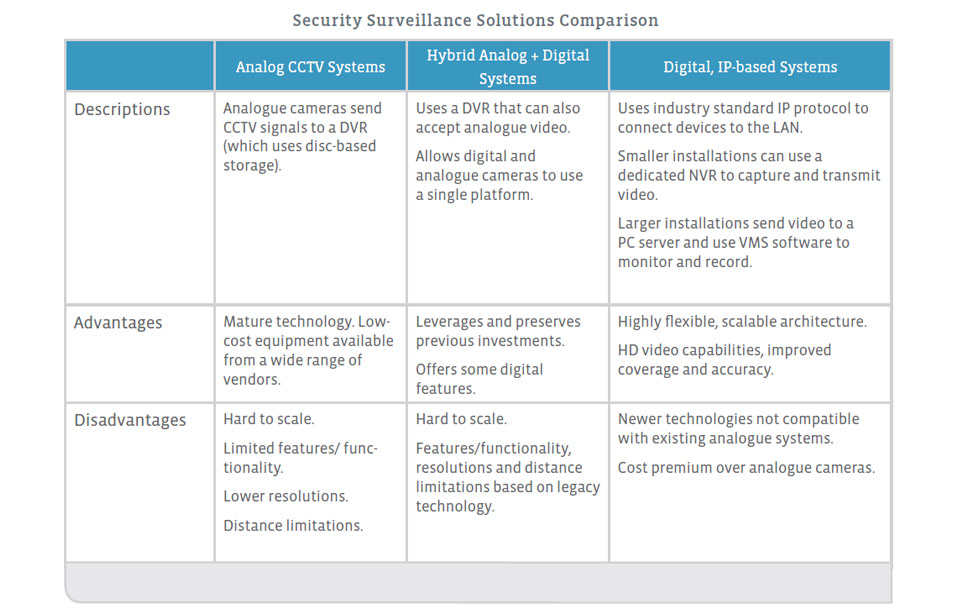
.jpg?sfvrsn=8a077468_4)
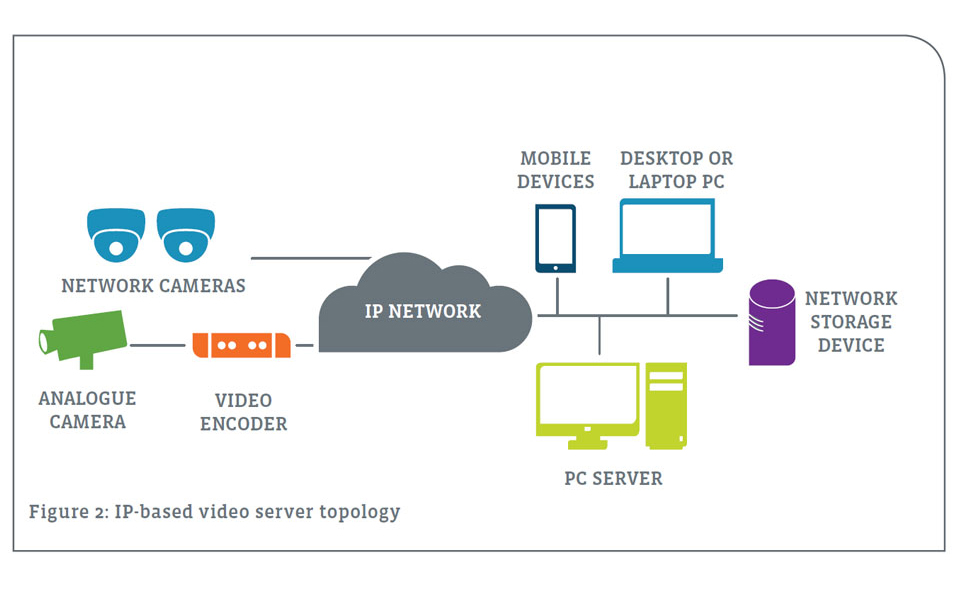
These solutions, often referred to as Video Content Analysis (VCA), are used to scrutinise large amounts of captured video data — either in real time or from storage. They allow organisations to extract useful business or security-related details that can be utilised in a couple ways:
The latest NVR appliances typically include basic Video Content Analytics capabilities, as do many standalone VMS packages. A number of vendors specialise in expanding the analytics capacity of these systems and offer training programmes to their channel partners. This is a real opportunity By some estimates there are more than 30 million cameras in the world capturing more than 250 billion hours of raw video footage each year. That is a staggering amount of information! Much like the early days of the Internet, before the rise of search engines, the sheer volume of data is simply overwhelming for businesses to grasp. But many are learning that by harnessing and leveraging that information, they can improve their operations or meet specific compliance requirements. Solution providers who can help their customers better organise and make sense of all their surveillance footage have a unique opportunity to drive more instals and increase their sales opportunities. That’s where video analytics comes in. Video Analytics: Create Real Customer Value Quick Start Guide to Physical Security CompTIA.org area for solution providers, offering a value add that many of their businesses customers could benefit from. Not only can they address their clients’ physical security concerns, but these advanced analytical capabilities allow them to highlight trends in their businesses. With that information in hand, customers can bolster their defences and strengthen their marketing and sales strategies̶ leading to a safer workplace and increased revenue opportunities. Security dealers seldom have much experience with internet services, servers, storage, and networking, and making that transition is neither quick nor easy. Add to this the fact that — as is the case with most technology innovations — legacy analogue solutions still enjoy somewhat of a cost advantage over the new digital platforms. The largest differential is with cameras. The analogue versions are readily available from a number of vendors at a very low price point. Solution providers who are capable at designing, implementing and managing these advanced analytical solutions will have a distinct advantage over those offering physical security services alone. With more complex technologies, compliance concerns and general business needs, organisations are relying more on skilled outsource partners to help them handle it all.
Security dealers seldom have much experience with internet services, servers, storage, and networking, and making that transition is neither quick nor easy. Add to this the fact that — as is the case with most technology innovations — legacy analogue solutions still enjoy somewhat of a cost advantage over the new digital platforms. The largest differential is with cameras. The analogue versions are readily available from a number of vendors at a very low price point. most technology innovations — legacy analogue solutions still enjoy somewhat of a cost advantage over the new digital platforms. The largest differential is with cameras. The analogue versions are readily available from a number of vendors at a very low price point. Solution providers who are capable at designing, implementing and managing these advanced analytical solutions will have a distinct advantage over those offering physical security services alone. With more complex technologies, compliance concerns and general business needs, organisations are relying more on skilled outsource partners to help them handle it all. If advanced security or analytics capabilities are not required — the lower cost analogue solution may be good enough. DSS may be a tough sell for the cost-conscious business owner. But the price gap is closing quickly and digital-based video cameras are expected to be on par with analogue devices within the next several years.
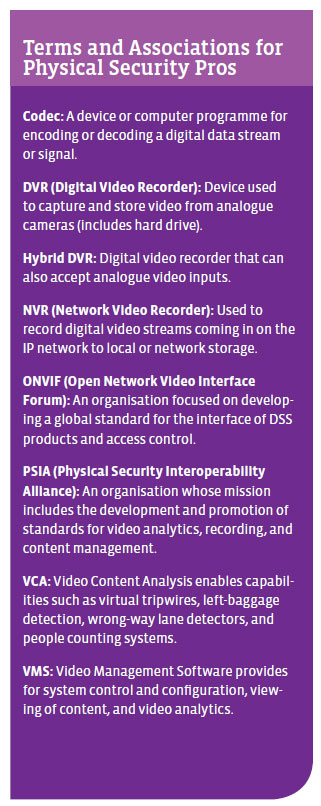
Even though the benefits of DSS far outweigh the legacy equipment, some buyers will require highly compelling reasons to discard their existing sys- 08 As compelling as the advantages are for DSS, the changeover has not happened quickly — and it still has a long way to go. A major reason for such a slow transition (more than ten years, and counting) is businesses’ continued reliance on security dealers for systems and support services. That community has a long history with legacy analogue solutions and is deeply invested in maintaining that infrastructure. Dealers understand how to market, sell, and service that equipment and, while digital surveillance may be hold some interest, it’s not a core competency for most — at least not yet. The Digital Transformation May Take Time tems. A hybrid approach may work well for those customers, allowing them to integrate the latest digital technologies with their existing infrastructure — a conservative option that leverages past, current and future investments.
The DSS market provides a compelling growth opportunity for solution providers who are looking to leverage their existing competencies in networking, storage, managed services and cloud computing. Physical security presents an opportunity to grow wallet- and mindshare with existing customers who are almost certainly buying security solutions today. A physical security offering also allows providers to attract new seats and expand into new and more lucrative markets (i.e. financial, education, healthcare
When surveillance technologies are incorporated into useful business solutions, providers can boost their recurring services revenue, traditional product sales and their support contract options. For example, by leveraging cloud-based storage, they can backup digital content files into a safe and secure location for their clients. They can employ managed services to ensure their customers’ security systems are up and running at all times. And, with high-resolution digital video capabilities, providers can sell incremental analytics services including identification, situation awareness, behaviour analysis, traffic flow, and other advanced capabilities.
The key to success in DSS is to offer a comprehensive portfolio of solutions and support options. Not just the cameras, recorders, storage, networking, and infrastructure solutions required to effectively manage these systems — but the core IT offerings every business customer needs. Physical security practices allow providers to expand their vertical expertise and spark deeper conversations, the discussions that lead to more long-term business opportunities.
As solution providers should do with every major business investment, spend time assessing the sales potential for physical security solutions in their particular markets. Are current clients already employing systems? If so, identify the company providing and supporting their platforms as well as the specific technologies they are using. Does the existing system solve their current and future business needs? Perform a basic assessment of their infrastructure, including the number of analogue and digital cameras, access controls, and whether they’re employing DVRs or NVRs.
There are three key factors that will help solution providers determine if they have a real opportunity to sell physical security to existing customers: recent investments, legacy infrastructure, and business goals. While the first two appear similar, some business clients may be reluctant to replace their older systems if they appear to be in good working order with no logical business need for replacing them. That’s why it’s so important to ask customers what they like and dislike about their existing physical security solutions. Are there features they need now or upgrades they want for the future? This is also a good time to take a deeper dive into the technologies, skills, and competencies required to be successful in this space. Many of the aptitudes needed here may already be covered and any training investments will likely complement their existing services portfolios. Network, server, and storage could be current areas of strength. Video formats and standards, camera and access control technologies plus installation will likely be new, requiring training and educational investments.
Once providers complete their research and gain a higher understanding of the opportunities, an initial financial analysis should be conducted to determine the potential impact this type of practice could have on the bottom line. The results of that process should help determine if a physical security practice makes good business sense, and whether they should move forward with the remaining steps.
Once a solution provider has completed the research step and decided that the DSS opportunity is attractive enough to move forward, it’s time to identify the specific solution set and service offerings the firm needs to develop and offer its own customers. Turnkey systems provide a quick and easy entry into the space, though they may be limited in capacity or scalability. These are typically self-contained NVRs that integrate a video server and storage with video management software (VMS). An alternative approach is to provide a customised DSS system tailored to meet the needs of each individual customer’s facilities and business needs.
A best practice for evaluating those options is to engage in discussions with the vendors of the equipment you’re interested in selling and supporting. Review their documentation, training processes, and partner and customer success stories. Be sure to evaluate the vendors on their physical security offerings and feature sets, as well as their technical, sales, and marketing support.
Finally, consider what service offerings you could logically attach to surveillance and access control solutions. Depending on vertical expertise and skill sets, that may include physical security assessments, installation, monitoring services, periodic camera cleaning, and maintenance and advanced video analytics. Many of these could be bundled into a recurring revenue service to better support your customers’ needs (and to build amore profitable DSS business).
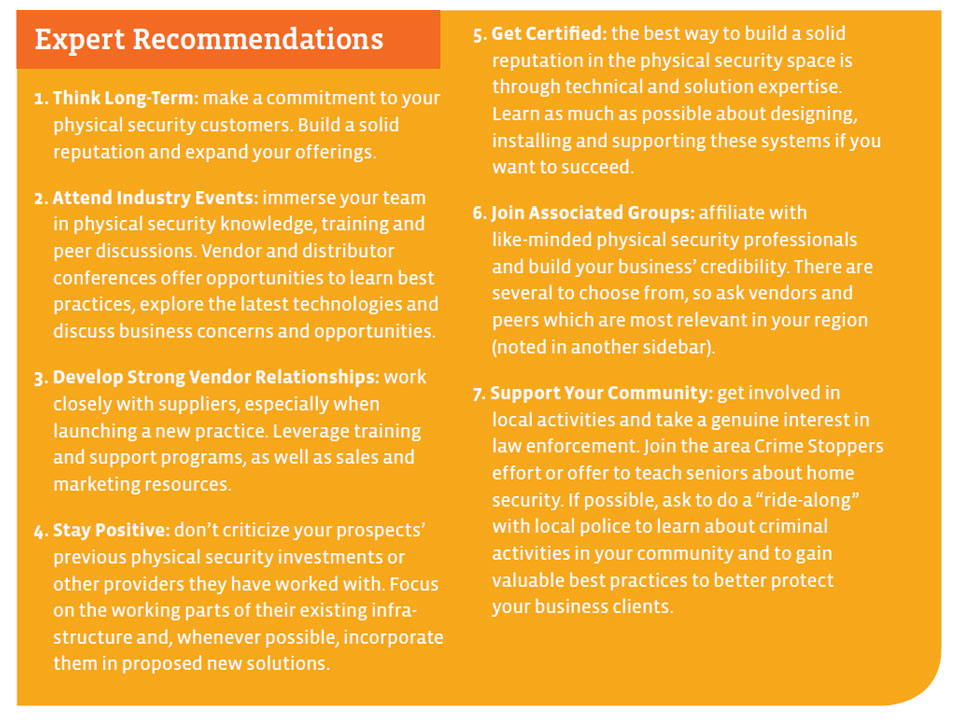
Once the solutions, services, and vendor options have been evaluated, it’s time to review internal resources. First off, providers need to identify and close any potential skill gaps that could hinder the launch and long-term success of their DSS practices. As is always the case, there are three primary methods for addressing this issue: 1) train existing staff on these solutions, 2) hire new staff members with those particular talents or 3) partner with other solution providers or experts with those skills.
Some of the more common gaps found at IT firms include:
A great starting point for building a physical security practice is to start with existing clients who are already consuming these services. They also make a good initial target audience for your DSS marketing plan. While these customers may be fairly familiar with your IT services, be sure to remember they will need a proper introduction to your latest security offerings. Some may already have a security provider, so you have to be prepared to deliver a more compelling value proposition. What benefits would they receive transitioning from their old analogue systems to the latest in digital technologies?
In other words, the value propositions you promote must extend beyond simply adding a physical security platform. Focus on the business benefits of an IP-based DSS solution and your company’s ability to support their comprehensive technology needs. For example, develop a value proposition based on the improved coverage and accuracy of HD video, showing customers and prospects how it can reduce both their risks and costs. Similarly, highlight the use of advanced video analytics to drive improved business intelligence, if it makes sense for your clients and markets. Consider promoting the profitability angle as well, showing how the business intelligence capabilities of these advanced solutions could boost their bottom lines.
To attract new customers, develop a plan that builds your company’s credibility as an expert in DSS. You might start an online marketing campaign, buying search terms and developing a blog that covers key issues SMB organisations face related to physical security area. Spread the word, tell your community why DSS technologies are solid business investments, and why their particular companies could benefit from their installation.
Don’t forget to highlight your new practice and expertise on your own website, as well as in your sales and marketing collateral.
Finally, look to leverage your chosen distributors and vendors for incent and funding programmes, marketing assets, and co-marketing materials that can be utilised in your own marketing campaigns.
Explore all the resources at your disposal and make good use of no- or low-cost materials.
In parallel with the development of the new practice’s marketing plan, solution providers should also be readying their customer engagement strategies. A successful DSS solution launch requires careful preparation of everyone in the organisation — especially for those charged with selling it to customers and prospects. Your physical security success lies with the sales team. They make the connexion and create the dialogue that, if the alignment is right, get businesses to sign on the dotted line.
The physical security field requires training, certifications, and sales tools that enable your team to easily demonstrate the value of DSS solutions to customers. Develop sales presentations and collateral around their particular offerings, as well as demo and trial programmes that help close deals.
Each sales professional should be prepared to discuss the analogue to digital transition and how that might fit each customer’s business needs. Some may desire a gradual conversion to DSS solutions, utilising as much of their past investments as possible while gaining some of Quick Start Guide to Physical Security CompTIA.org the features and capabilities they need from the new platforms. The hybrid model is an attractive option for potential customers, and your sales team will play a crucial role in connecting the dots based on each prospect’s unique value need. That process starts with discussions around business goals and past investments in their physical security infrastructure, and continues along until your team delivers a plan that makes the best financial and operational sense for the customers.
Sales teams have to think of every new engagement as a service opportunity. Should the solution include maintenance, storage, and analytics add-on services? If it creates value and ensures a more successful customer experience, the answer should be a resounding ‘Yes!’ The win-win scenario is just as applicable in physical security as it is with other IT solutions.
The final step of building a physical security strategy is reviewing and possibly amending compensation plans. Are your existing incent plans going to help or hurt your DSS solution goals? Depending on the mix of expected product resale and services revenue, the compensation plan may need to be adjusted. Run the numbers and get feedback from the sales team. Are they excited about the opportunity to sell physical security? Will the incent package hurt or help sales of your other IT solutions? Check with vendors and peers for recommendations and be willing to amend your plan along the way, if needed.
Once steps one through five have been completed, you should be ready to launch your DSS business. Start rolling out the marketing campaign to existing customers and elicit their feedback. Engage a few clients at a time and start a beta programme with the initial group. That will help your team gain experience in critical system design, project estimation, installation, and configuration. Once those projects are complete, assess whether they were as profitable as planned. Take into account that the processes were being developed with the initial group, so future instals should require less time and effort as the team hits its stride. Be sure to document all installation procedures — or at least those that will be repeated in the future — for training and process improvement purposes. That also gives your team the ability to adjust pricing for future DSS system bids, helping to ensure those projects and the business unit remain profitable.
MarketsandMarkets, Physical Security Market by System (Access Control, IP Video Surveillance Software, Locks, PSIM, PID), Services (System Integration, Maintenance & Support, and Designing & Consulting), Vertical, and Region — Global Forecast
to 2020.
http://www.marketsandmarkets.com/Market-Reports/physical-security-market-1014.html
Read more about Cybersecurity.
Tags : Cybersecurity